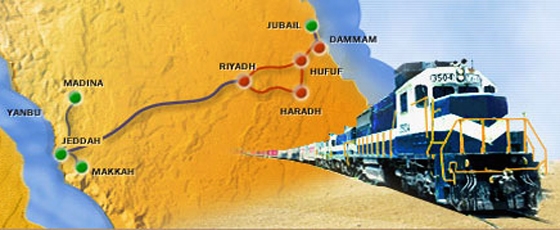The scale of the investment in developing rail networks in Saudi Arabia, both nationally and in the major cities, can only really be appreciated by visiting this huge country. It is not just the number of large projects underway and planned which is impressive, but the speed at which the Saudis want to implement them.
The main spur to developing the rail network stems from King Abdullah's decision to diversify the Saudi economy away from its dependence on the oil and petrochemical industries to exploit the huge mineral deposits which have lain untapped beneath the desert. The Saudis recognized that the only way to transport the minerals efficiently is by rail and so the North-South Railway is being built to International Heavy Haul Association standards, like the United Arab Emirates' first mineral line currently under construction by Etihad Rail.
There was also a pressing need to find a more efficient, comfortable and safe way to transport the more than 3 million pilgrims who each year visit the two holy cities of Mecca and Medina in the west of the country. The solution chosen here was a 300km/h line built to European high-speed standards, construction of which is now well advanced.
"We have already invested in the road network and airports, so now we need to develop the rail network," Saudi Arabia's transport minister, Dr Jubarah bin Eid Al-Suraiseri, explained to me in Dammam last month. "The biggest challenge is to complete everything on time and to have all the resources – raw materials and expertise – in place in order to achieve everything."
The Landbridge linking the Red Sea port of Jeddah with the capital Riyadh, where it will link with Saudi Railway Organisation's existing railway to the Gulf port of Dammam, was intended as the first of three major rail projects in Saudi Arabia, before the North-South Railway and the Haramain high-speed line leapfrogged ahead of it. The Saudi government wanted to build the Landbridge as a build-operate-transfer (BOT) scheme, but it failed to excite private investors who were sceptical about its ability to get shipping companies to transfer containers from sea to rail despite the large time saving rail would offer compared with the sea voyage around the Arabian peninsula.
The attempt to pursue a BOT scheme in a country with such huge financial resources at its disposal was also unusual. But the government has learnt its lesson and is now funding the huge rail expansion underway in Saudi Arabia. This includes the Landbridge, which will be constructed by Saudi Railway Company (SAR), which is currently completing the North-South Railway.
The decision to split the responsibility for these huge projects between two railways – SRO is overseeing construction of the Haramain high-speed line – is commendable, as the scale of the work is probably too great for one organization to manage effectively. Strong project management is vital for success, especially when so much work is underway simultaneously.
The president of SRO, HE Mohammad Khalid Al-Suwaiket, is pushing the Spanish contractors to open the northern part of Haramain high-speed line as soon as possible. He is keen to start seeing a return on the investment and to gain experience operating the new railway – the world's first high-speed line to operate in desert conditions – ahead of opening the southern section to Mecca which will carry the majority of passengers.
Al-Suwaiket also wants to bring forward by 10 years completion of the national plan to build 9900km of railways by 2040. While the 2750km North-South Railway and the 450km Haramain line are under construction, and plans for the 950km Landbridge and the 663km Saudi part of the 2177km Gulf railway are well advanced, this still leaves more than 5000km to build by 2030.
On top of this, SRO is also engaged in developing its existing railway as Al-Suwaiket wants to ramp up passenger and freight traffic as fast as he can.
Achieving modal shift to rail is a huge challenge in a country where road and air transport is already well developed and extremely cheap to use. Fuel is almost free-of-charge, as there is no taxation in Saudi Arabia, and there are no restrictions on parking in major cities.
But there are encouraging signs that rail can win traffic from other modes. One of rail's big advantages over road is safety, as Saudi roads are among the most dangerous in the world as young men drive their powerful cars to the limit. The distances between cities are great, which favors railfreight. SRO already carries the majority of the containers moving between Dammam and Riyadh, which bodes well for the Landbridge, and it is winning other freight from road. Its passenger business is growing strongly, which has given it the confidence to pursue plans for a high-speed line between Riyadh and Dammam.
The biggest challenge remains in the cities where Saudis currently depend on their cars, with public transport apart from taxis virtually non-existent. But the planners recognize this and are already testing restrictions on road users in Riyadh. A steadily increasing population will inevitably lead to worsening road congestion which will also help to encourage Saudis to leave their cars at home and try the new high-quality public services when they start to arrive later this decade.
Rail Journal
3 June

























































